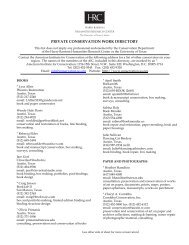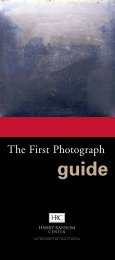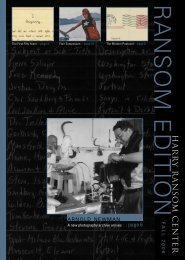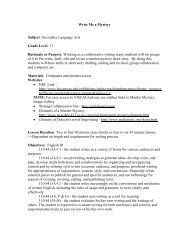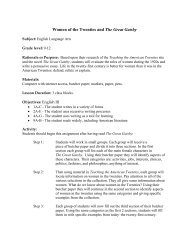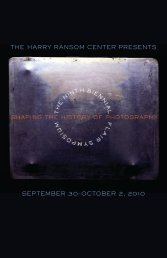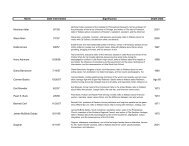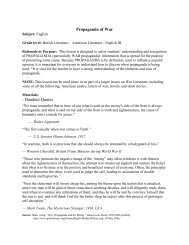HARR Y R ANSO M CENTER
HARR Y R ANSO M CENTER
HARR Y R ANSO M CENTER
You also want an ePaper? Increase the reach of your titles
YUMPU automatically turns print PDFs into web optimized ePapers that Google loves.
Tennessee Williams : : page 4 Gone With The Wind : : page 14 Recommended Reading : : page 13<br />
a po rt r a i t of a di r e c t o r<br />
Tom Staley and the Ransom Center : : page 8<br />
R<strong>ANSO</strong>M EDITION<br />
SPRING 2011<br />
Harry ransom Center
R<strong>ANSO</strong>M EDITION<br />
Volume 19 : : Issue 1<br />
SPRING 2011<br />
R<strong>ANSO</strong>M EDITION is published<br />
biannually for members and friends<br />
of the Harry Ransom Center at<br />
The University of Texas at Austin.<br />
To change your contact information,<br />
please notify:<br />
Alicia Dietrich, Editor<br />
Ransom Edition<br />
Harry Ransom Center<br />
The University of Texas at Austin<br />
P.O. Box 7219, Austin, TX 78713<br />
aliciadietrich@mail.utexas.edu<br />
HOURS – Ransom Center Galleries<br />
Tuesday, Wednesday, Friday<br />
10 a.m. to 5 p.m.<br />
Thursday 10 a.m. to 7 p.m.<br />
Saturday and Sunday noon to 5 p.m.<br />
Library Reading Room and<br />
Visual Materials Viewing Room<br />
Monday–Friday 9 a.m. to 5 p.m.<br />
Saturday 9 a.m. to noon<br />
(No Saturday hours for visual<br />
materials viewing)<br />
Phone: 512-471-8944<br />
Fax: 512-471-9646<br />
www.hrc.utexas.edu<br />
Stay connected with the Ransom<br />
Center and its latest news through<br />
eNews, the Cultural Compass blog,<br />
Twitter, Facebook, and YouTube.<br />
Visit www.hrc.utexas.edu/connect.<br />
Alicia Dietrich Editor<br />
Anne-Charlotte Patterson Designer<br />
Leslie Ernst Art Director<br />
Daniel Zmud Webmaster<br />
Unless otherwise noted,<br />
photography by Pete Smith<br />
or Anthony Maddaloni.<br />
Cover: Tom Staley.<br />
Cover background image:<br />
Etchings on the first-floor windows of<br />
the Ransom Center that depict holdings<br />
from the Center’s collections.<br />
The publishers have made every effort to<br />
contact all copyright holders for permissions.<br />
Those we have been unable to reach are<br />
invited to contact us so that a full<br />
acknowledgment may be given.<br />
© 2011 Harry Ransom Center.<br />
All rights reserved.<br />
The Ransom Center enjoys considerable recognition for its extensive collections, its<br />
acquisitions, and its visits from distinguished writers and artists, but it is the quality of the<br />
Center’s very talented staff that makes this place truly remarkable. I have tremendous<br />
admiration for my colleagues here at the Center, who support our mission each day with<br />
eagerness and enterprise. It is deeply satisfying to know that the Center and<br />
our celebrated collections are in the care of such bright, enthusiastic, and<br />
immensely talented people.<br />
Working closely with our staff is an equally dedicated group of individuals<br />
who serve on the Ransom Center’s Advisory Council. As many of you<br />
are well aware, the Ransom Center is in the midst of a capital campaign<br />
to raise $15 million to support and enrich the Center’s collections and<br />
initiatives. The campaign continues until 2014, and I am very pleased to<br />
report that we are more than two-thirds of the way toward reaching our goal.<br />
We owe much of our success thus far to our Advisory Council members, who<br />
not only have contributed personally and generously to the campaign but<br />
have also helped attract invaluable gifts from other donors and foundations.<br />
Over the years, the Ransom Center’s Advisory Council has become legendary<br />
on this campus for its support, commitment, and achievements. It is also<br />
looked to with envy for including some of the brightest, wittiest, and most<br />
enthusiastic supporters of this University. The Center is indeed fortunate<br />
to have maintained such wonderful supporters and very good friends over<br />
the years.<br />
Many important activities and initiatives have been occupying our attention<br />
in recent months. In October, the Center received visits from Jim Leach,<br />
the chairman of the National Endowment for the Humanities, and Sam<br />
Tanenhaus, editor of The New York Times Book Review. Chairman Leach<br />
took a tour of the Center and gave an engaging presentation about the<br />
importance of civility in public discourse. Sam Tanenhaus spoke<br />
enthusiastically with staff and faculty about book reviewing and archives.<br />
We also recently added to our collections the archive of writer and<br />
performer Spalding Gray, which you’ll read about in this newsletter. It is<br />
a rich collection that we believe will be of great interest to scholars and<br />
students. And, we are in the midst of several exciting negotiations for new<br />
archives that will enrich our collections in the months to come.<br />
Thomas F. Staley,<br />
Director, Harry Ransom Center<br />
´<br />
DIREcTOR’S NOTE
denotes a link to additional materials<br />
on the Ransom Center’s website<br />
8<br />
A Portrait of a Director<br />
Tom Staley and the Ransom Center<br />
2<br />
3<br />
Recent<br />
Acquisitions<br />
Spalding Gray<br />
News<br />
David Foster Wallace<br />
papers open<br />
for research<br />
TOP LEFT: Tom Staley, Fleur Cowles, and<br />
Tom Stoppard during the 1996 Flair Symposium,<br />
Shouting in the Evening: British Theater 1956–1996.<br />
cONTENTS<br />
Current Exhibitions : :<br />
Becoming Tennessee Williams<br />
and Culture Unbound:<br />
Collecting in the<br />
Twenty-First Century 4<br />
Upcoming Exhibitions : :<br />
Banned, Burned, Seized,<br />
and Censored and<br />
Browsing in Bohemia:<br />
The Greenwich Village<br />
Bookshop Door, 1921–1925 5<br />
Recommended Reading : :<br />
Books featured in Culture<br />
Unbound exhibition 13<br />
Philanthropy : : Fans<br />
donate $30,000 to<br />
conserve Gone With<br />
The Wind dresses 14<br />
Scholarly Publications : :<br />
Recently published books<br />
based on research at the<br />
Ransom Center 15<br />
Before and After : :<br />
Page proofs for James<br />
Joyce’s Ulysses 16<br />
National Endowment for<br />
the Humanities Chair visits<br />
the Ransom Center back cover<br />
Ransom Edition : : 1
Recent Acquisitions<br />
Audio cassette and video cassette tapes from the Spalding Gray<br />
archive. The archive contains more than 150 audio tapes and<br />
more than 120 VHS tapes.<br />
UPDATED VERSION OF GUiDE To ThE<br />
CollECTionS NOW AVAILABLE ONLINE<br />
The Guide to the Collections on the Ransom Center’s website<br />
has been revised and updated, replacing one based largely<br />
on the published edition of 2003 (now out of print). The guide<br />
supplements collection-level cataloging by emphasizing topical<br />
access across the collections.<br />
Changes in scholarship since the first edition of the guide<br />
was published in 1990 are reflected in the new version. For<br />
example, there wasn’t a Gay and Lesbian chapter in the 1990<br />
guide; one was added in 2003, and in 2010 it has expanded<br />
into a long section on Lesbian, Gay, Bisexual, Transgendered,<br />
and Queer (LGBTQ) studies. The history of the book was just<br />
finding its way as a discipline back in 1990 (when it was “Book<br />
Arts”). The current version includes a much wider variety of<br />
Ransom Edition : : 2<br />
The Ransom Center has acquired the archive of<br />
noted author, performer, and actor<br />
Spalding Gray (1941–2004), who is best known as the<br />
creator and performer of autobiographical monologues such as<br />
Swimming to Cambodia (1985) and Monster in a Box (1992). The<br />
extensive archive traces Gray’s career and personal life over more<br />
than four decades.<br />
The collection includes more than 90 handwritten performance<br />
notebooks that served as templates for Gray’s live performances.<br />
The notebooks are heavily revised and annotated, demonstrating<br />
the development of Gray’s most significant pieces. Gray continually<br />
expanded and revised his monologues based on audience reception<br />
and his own changing needs as a performer, and nearly all of the<br />
notebooks contain additional handwritten pages inserted by Gray.<br />
The collection also includes over 100 private journals. These are largely<br />
diaristic, filled with witty asides detailing everyday experiences, pages<br />
of philosophical reflection, dream records, and Gray’s examination of<br />
his own moral nature. Together, the performance notebooks and private<br />
journals provide insight into how Gray’s works were drawn from his<br />
most intimate and personal reflections on his daily experiences.<br />
The collection contains other unpublished writing, including short<br />
stories, plays, and poems. Substantial audio and video materials,<br />
resources. A full chapter on<br />
African Studies has now<br />
grown out of a small section<br />
on African literature.<br />
The entire guide text is searchable<br />
using the website’s search<br />
feature. A new “portal” to the<br />
finding aids for archival and<br />
visual collections has also been<br />
added to the website, which<br />
Plantin Polyglot Bible,<br />
1569–1573.<br />
allows easy browsing by collection name and type of material<br />
as well as keyword searching.<br />
8 Learn more at www.hrc.utexas.edu/ransomedition
First page of Spalding Gray’s performance notebook for Swimming to<br />
Cambodia. This notebook features Ronald McDonald on the cover, and<br />
Gray is seen using this notebook in his performance of Swimming to<br />
Cambodia in the 1987 film by Jonathan Demme.<br />
including 150 audio tapes and over 120 VHS tapes, will allow scholars and<br />
students to trace the evolution of Gray’s work in front of an audience, the<br />
arena for which he was best known. The archive also includes an extensive<br />
collection of personal correspondence.<br />
Gray’s life and work were the focus of Steven Soderbergh’s 2010<br />
documentary film And Everything Is Going Fine. A portion of this archive was<br />
generously donated to the Ransom Center by Gray’s widow, Kathleen Russo.<br />
Other acquisitions include<br />
:: Jorge Luis Borges’s handwritten manuscript about William Blake.<br />
:: A collection of more than 250 letters written by Bernard Malamud to his<br />
literary agent, which include a number of typescripts and story fragments.<br />
:: The first draft of Oscar Saul’s screenplay of A Streetcar Named Desire, which is<br />
marked throughout with Tennessee Williams’s handwritten revisions.<br />
:: The library of literary critic Hugh Kenner, a gift from Mary Ann Kenner.<br />
David Foster Wallace Archive<br />
Now Open For Research<br />
The archive of David Foster Wallace (1962–2008), author of Infinite Jest (1996), The Broom of<br />
the System (1987), Girl with Curious Hair (1989), and numerous collections of stories and essays,<br />
is now open for research.<br />
The Center acquired Wallace’s archive last year. The collection is made up of 34 boxes and<br />
is divided into three main sections: works, personal and career-related materials, and copies<br />
of works by Don DeLillo. The works section covers the period between 1984 and 2006 and<br />
includes material related to Wallace’s novels, short stories, essays, and magazine articles.<br />
The personal and career materials section covers 1971 through 2008 and includes juvenilia,<br />
teaching materials, and business correspondence. Most of the correspondence in the collection<br />
is between Wallace and his editors and is related to his work. The third, and smallest, section<br />
includes photocopy typescripts of three works by DeLillo, one of which, Underworld, contains<br />
extensive handwritten annotations by Wallace. The archive also contains more than 300<br />
books from Wallace’s library, many of them heavily annotated.<br />
Because of high demand for study of this collection, the Center requests that researchers<br />
inform curatorial staff of their research plans in advance. To enable staff to best serve researchers’<br />
needs, the Center asks that researchers include the dates of their planned visit and a brief description<br />
of the sections of the collection they expect to study.<br />
8 For more information, including links to a finding aid, an inventory of Wallace’s library,<br />
and images of teaching materials and annotated books, visit www.hrc.utexas.edu/dfw.<br />
“Zero” draft of David Foster Wallace’s 2005<br />
commencement speech at Kenyon College.<br />
Ransom Edition : : 3
cURRENT EXHIBITIONS<br />
Ransom Edition : : 4<br />
February 1–July 31, 2011<br />
Becoming Tennessee Williams<br />
With his plays The Glass Menagerie (1945) and<br />
A Streetcar Named Desire (1947), the American<br />
playwright Tennessee Williams (1911–1983)<br />
reinvented the theater. Drawing on the Ransom<br />
Center’s extensive collection of Tennessee Williams<br />
manuscripts, correspondence, photographs, and<br />
artwork, this centenary exhibition explores the idea,<br />
act, and process of artistic creation, illuminating<br />
how Thomas Lanier Williams became Tennessee<br />
Williams. Williams asserted that most of his plays<br />
dealt with the “wild at heart kept in cages,” a<br />
description, perhaps, of his own life. Throughout<br />
the exhibition, Williams’s personal biography is<br />
compared and contrasted with the dramatic<br />
structure of his plays.<br />
JOin US FOR “WiLd At HEARt”<br />
Celebrate the opening of our upcoming<br />
exhibitions Becoming Tennessee Williams<br />
and Culture Unbound: Collecting in the<br />
Twenty-First Century on Friday, February 4,<br />
2011. Become a member now to receive your<br />
complimentary ticket and valet parking.<br />
Non-members may purchase tickets to the<br />
event for $20 (valet parking included). Learn<br />
more at www.hrc.utexas.edu/wildatheart.<br />
Culture Unbound: Collecting in<br />
the Twenty-First Century<br />
This exhibition commemorates the Ransom<br />
Center’s tireless hunt for archives that will<br />
capture the imagination, invigorate scholarly<br />
research, and deepen our understanding<br />
of culture. Highlighting major acquisitions<br />
in this new century, the exhibition demonstrates<br />
how the Center builds a collection<br />
of interrelated archives that strengthen and<br />
give context to one another. The exhibition<br />
showcases materials from both major and<br />
lesser-known figures, from writers David<br />
Mamet, David Foster Wallace, and Don<br />
DeLillo to Brian Moore and Jayne Anne<br />
Phillips, from journalists Bob Woodward<br />
and Carl Bernstein to acting teacher Stella<br />
Adler. The exhibition explains how archives<br />
come to the Ransom Center and how they<br />
contribute to our cultural history.<br />
kept in cages<br />
williams<br />
the wild at heart<br />
tennessee<br />
a prayer for<br />
becoming
September 6, 2011–January 29, 2012 UPcOMING<br />
Banned, Burned, Seized,<br />
and Censored<br />
How did hundreds of thousands of books, pictures,<br />
plays, and magazines come to be banned, burned,<br />
seized, and censored in the span of less than 30<br />
years? This exhibition reveals the rarely seen<br />
“machinery” of censorship in the United States<br />
between the two world wars. Using tactics from<br />
extra-legal intimidation to federal prosecution,<br />
censors from the New York Society for the<br />
Suppression of Vice, New England’s Watch and<br />
Ward Society, the Post Office Department, and the<br />
Treasury Department waged war on “objectionable”<br />
literature. Larger-than-life personalities battled<br />
publicly over obscenity, “clean books,” and freedom<br />
of expression while writers, agents, and publishers<br />
attempted to navigate the increasingly complex<br />
world of American censorship.<br />
“Books are weapons in the war of ideas,”<br />
S. Broder, Office of War Information, Poster Number 7,<br />
U.S. Government Printing Office, 1942.<br />
Browsing in Bohemia: The Greenwich Village<br />
Bookshop Door,<br />
1921–1925<br />
As early as 1921,<br />
noteworthy visitors to<br />
Frank Shay’s bookshop,<br />
located at 4 Christopher<br />
Street in the heart of<br />
Greenwich Village, began<br />
signing the narrow door<br />
that opened onto the<br />
store’s back room. When<br />
Envelope from a letter sent from Frank Shay’s Bookshop to Christopher Morley.<br />
the shop closed in 1925,<br />
manager Juliette Koenig preserved the door and, with it, a revelatory slice of cultural history. Signed by 238 writers,<br />
artists, actors, publishers, and other community members, this unusual artifact presents a unique opportunity to<br />
reconstitute the intersecting communities that made the Village an epicenter of American modernism. The exhibition<br />
unravels the dense web of professional, intellectual, and personal connections that may be found between many of<br />
the seemingly unrelated names on the door and shows how a single artifact can set off a chain reaction, revealing<br />
connections and influences that are otherwise forgotten.<br />
EXHIBITIONS<br />
Ransom Edition : : 5
Research at the Ransom Center<br />
Tennessee Williams<br />
ALbERt J. dEVLin<br />
A decade’s work on The Selected Letters of<br />
Tennessee Williams (two volumes, published by<br />
New Directions, 2000–2004) and subsequent work on the<br />
correspondence of Elia Kazan (forthcoming from Alfred A. Knopf)<br />
has required on-site research at major and not-so-major libraries<br />
from Boston to Los Angeles. The majority of my stops, however,<br />
have been in the middle, or nearly the middle, at the Harry Ransom<br />
Center, which holds the Williams collection as well as material<br />
pertinent to Elia Kazan. It has become a cliché to mark the Ransom<br />
Center as preeminent among research libraries and to thank the<br />
public services staff—formerly Cathy Henderson and Tara Wenger,<br />
currently Richard Workman, forever Pat Fox—for their courtesy and<br />
expertise. On more than one occasion Rich Oram, Associate<br />
Ransom Edition : : 6<br />
Director, has offered sound advice and encouragement for<br />
which I remain thankful.<br />
The Williams collection was partially organized, I suspect, by<br />
Andreas Brown, former owner of the Gotham Book Mart, who<br />
helped to direct the playwright’s voluminous papers to the Center.<br />
But what the library received probably bore a greater resemblance<br />
to the welter of material that Elia Kazan encountered in directing<br />
Camino Real (1953): “I took all the versions from A to infinity on the<br />
train with me. I sat down one morning and ripped the covers off<br />
and went thru every page. By nightfall I was blind. (I recovered my<br />
sight just a few hours ago, in time to write this). The floor of my<br />
compartment was a foot and a half deep with your crumpled<br />
Tennessee Williams holding a photograph of Elia Kazan, not dated. Unidentified photographer.
Early draft of A Streetcar named Desire titled<br />
“The Passion of a Moth,” in which Williams instructs a<br />
typist to change Kowalski’s name from Ralph to Stanley.<br />
Copyright © 2011 by the University of the South. Reprinted by<br />
permission of Georges Borchardt, Inc. All rights reserved.<br />
efforts” (from Kazan’s letter to Tennessee Williams, dated<br />
December 10, 1952, in the Ransom Center’s collection). Smoothed<br />
and sorted and dated with astonishing accuracy, well before key<br />
bio-bibliographical aids were available, are fragmentary drafts,<br />
composite manuscripts, and a multitude of letters that cover the<br />
waterfront of taste.<br />
The Center’s collection indicates that Williams wrote often and<br />
“badly” in order to write well. He tested at least eight titles,<br />
including “Electric Avenue,” before settling on A Streetcar Named<br />
Desire (1947). He did not destroy or otherwise withhold the many<br />
drafts of Streetcar—a fellow southerner, Eudora Welty, was loath<br />
to have similar “mistakes” revealed—but, like a visual artist,<br />
unabashedly used “studies” to probe the dynamics of character and<br />
motivation. Especially revealing is an undated draft of the “morning<br />
after” scene in which Blanche DuBois and Stanley Kowalski marvel<br />
at their sexual performance—however enforced it may have been<br />
at first. “Since we’re exchanging bouquets,” Blanche says, “let me<br />
add this one. Everything’s been a preparation for you in what I’ve<br />
gone through. I’m really surprised the walls are still standing. There<br />
was one moment when I thought we were lying out-doors halfway<br />
between this crazy old world and the moon!” Williams has overtly<br />
dramatized the allure of the man who will finally be Blanche’s<br />
“executioner.” Traces of the surprising scene, probably related<br />
to a draft entitled “The Passion of a Moth,” would remain in the<br />
production text in Blanche’s flirtation with Stanley, as well as her<br />
“bouquet,” which is refined of its former dramatic excess, endowed<br />
with foreboding, and presented to Stanley as a herald of rape:<br />
“I said to myself—‘My sister has married a man!’” What did<br />
Williams test and confirm in this study if not the unstable amalgam<br />
of strength and frailty that comprises Blanche DuBois and the<br />
power of Stanley to exploit it?<br />
8<br />
2011 PROMOTIONAL SPONSORS<br />
The Ransom Center would like to give special thanks<br />
to our 2011 promotional sponsors.<br />
A decision made long ago by the Center’s founder, Harry<br />
Huntt Ransom, to emphasize modern writers and collect their<br />
pre-production materials is perfectly consonant with the inner life<br />
of Tennessee Williams’s career. The sheer mass and inclusiveness<br />
of the Williams collection at the Center eloquently bespeaks the<br />
endurance of a writer whose apprenticeship to the theater was<br />
prolonged, whose dramatic “attack” was seldom efficient or<br />
uncluttered, and whose master works evolved slowly in conformity<br />
with alternating moods of confidence and desperation.<br />
Albert J. Devlin is the Catherine Payne Middlebush Professor of English<br />
at the University of Missouri and the author of The Selected letters of<br />
Tennessee Williams (2 vols., New Directions, 2000–2004). Devlin was a<br />
recipient of a Fleur Cowles Fellowship.<br />
Learn more about the Tennessee Williams collection at the Ransom Center at www.hrc.utexas.edu/ransomedition.<br />
Ransom Edition : : 7
A Portrait of a Director<br />
Staley in 1997 with the Oklahoma State Constitution, which underwent<br />
conservation work in the Ransom Center’s conservation department.<br />
tOM StALEy And tHE RAnSOM CEntER<br />
1988<br />
Thomas F. Staley is named director<br />
Amos Tutuola collection<br />
1989<br />
Stuart Gilbert collection of James Joyce<br />
materials Penelope Fitzgerald papers<br />
Anvil Press poetry archive<br />
1990<br />
Samuel Beckett letters to Kay Boyle and<br />
materials related to the publication of<br />
Beckett’s Beginning to End Transcription<br />
Center archive Steve Martin<br />
collection<br />
Ransom Edition : : 8<br />
Tom Staley and<br />
the Ransom Center<br />
ELAnA EStRin<br />
Shortly after becoming Director of the Harry Ransom Center<br />
in 1988, Tom Staley learned from his colleague Carlton Lake<br />
that the archive of Stuart Gilbert, James Joyce’s friend and<br />
collaborator, might be available. As a Joyce scholar, Staley had<br />
had his eye on Gilbert’s archive for years. He asked a rare book<br />
dealer to travel to Paris and visit Gilbert’s eccentric widow,<br />
whom Staley had visited in her apartment during one of his<br />
Joycean excursions many years earlier. Moune Gilbert had kept<br />
the collection stashed under her dining room table and hadn’t<br />
let anyone touch it in 20 years. After much deliberation, Staley<br />
and the dealer convinced Mrs. Gilbert to sell the archive to the<br />
Ransom Center.<br />
But first, they had to find a way to get the collection out of<br />
France and on its way to Texas. Concerned that French customs<br />
officials might block the collection’s export, they devised a plan<br />
to rent a bread truck, hide the papers under blankets, and drive<br />
1991<br />
John Fowles archive Elizabeth Hardwick<br />
collection, including materials by Robert<br />
Lowell Roy Harvey and Julius Patteson<br />
photography collection<br />
John Fowles, date and photographer unknown. John Fowles collection.
it to the English Channel on Holy Thursday when they figured<br />
customs officials wouldn’t be as vigilant. The plan worked, and<br />
the papers arrived safely in Austin, Texas.<br />
Combing through the collection, Staley found much more than he<br />
had expected. Even more valuable than the thousands of Swiss<br />
francs hidden throughout the collection (which Mrs. Gilbert<br />
refused to take back) and Gilbert’s diary (which Staley later coedited<br />
and published), Staley discovered a Joyce scholar’s dream<br />
come true. As he recounted: “I realized that I had before me the<br />
famous lost link, the missing draft with Joyce’s corrections in<br />
his own hand to an important segment of Finnegans Wake, an<br />
item more valuable than the price we had paid for the entire<br />
collection.”<br />
The Gilbert collection was one of Staley’s first acquisitions for<br />
the Ransom Center, purchased only a few months after he took<br />
his post as Director. The momentum hasn’t slowed down since.<br />
Staley has not only acquired many of the Center’s most important<br />
collections, he’s also lifted the Center to its current reputation as<br />
one of the world’s finest humanities research centers. Staley will<br />
retire on August 31 after 23 years as one of the most visionary<br />
directors and a trailblazer in the special collections field.<br />
“He’s one of the most incredible, dynamic, and charismatic<br />
leaders in the library profession,” says Richard Ovenden,<br />
Keeper of Special Collections and Associate Director of Oxford<br />
University’s Bodleian Library.<br />
1992<br />
Eliot Elisofon archive Christine Brooke-Rose<br />
papers John Crowley papers<br />
1993<br />
Tom Stoppard archive Isaac Bashevis<br />
Singer archive David Hare archive Warren<br />
Skaaren archive Sybille Bedford archive<br />
1994<br />
Laurence Pollinger collection<br />
of Graham Greene materials<br />
Audrey Wood papers James<br />
Saunders archive Initiation<br />
of the Fleur Cowles Flair Symposium<br />
Logo for Flair Symposium.<br />
“ You could get a scholar to do that<br />
job, you could get the head of a<br />
rare books library, you could get a<br />
terrific fundraiser. You could get<br />
somebody who had even two of<br />
those three attributes. But you<br />
can’t get anyone like Tom Staley.”<br />
From left, University Co-Op President George Mitchell, Grace Hightower,<br />
Thomas F. Staley, and Robert DeNiro at an event in 2007. De Niro donated<br />
his archive to the Ransom Center in 2006.<br />
1995<br />
John Osborne papers Karl Shapiro<br />
correspondence Adrienne Kennedy archive<br />
Peter Matthiessen papers<br />
Laurette Taylor collection<br />
1996<br />
David Douglas Duncan<br />
photography archive<br />
Penelope Lively archive<br />
Hugh Kenner archive<br />
Frith Banbury papers Ruth<br />
Robertson image archive<br />
Leica camera fitted with a Nikkor lens for photographer David Douglas Duncan.<br />
Ransom Edition : : 9
A Portrait of a Director continued<br />
Staley can often be spotted bounding down the Ransom Center’s<br />
halls, greeting colleagues and visitors with hearty pats on the<br />
back. His friends and colleagues describe him as energetic, fun,<br />
ebullient, vivacious, mercurial, charming, dogged, generous,<br />
kind, and a formidable scholar with a wild sense of humor.<br />
His colleagues agree that he is the perfect combination of<br />
scholar, administrator, fundraiser, and friend.<br />
“Nobody duplicates Tom’s multi-faceted capacities,” says London<br />
book dealer Rick Gekoski. “You could get a scholar to do that job,<br />
you could get the head of a rare books library, you could get a<br />
terrific fundraiser. You could get somebody who had even two of<br />
those three attributes. But you can’t get anyone like Tom Staley.<br />
Tom is out on his own. He’s sui generis.”<br />
When Staley arrived on campus, he had his work cut out for him.<br />
The Ransom Center had earned a solid reputation in the years<br />
after it was founded in 1957 but had lost much of its momentum<br />
over these years.<br />
Ransom Edition : : 10<br />
Staley and Advisory Council Member Frank Calhoun<br />
tour the Ransom Center as it underwent a renovation.<br />
1997<br />
Anthony Burgess archive Leon Uris<br />
archive Anita Desai papers Jay<br />
Neugeboren archive Diane Johnson<br />
papers<br />
1998<br />
Bernard Malamud archive Gordon<br />
Dickerson collection of modern British<br />
playwrights Fiction Collective archive<br />
Elizabeth Olds papers<br />
1999<br />
Arnold Wesker archive Terrence<br />
McNally papers Lee Blessing papers<br />
Jorge Luis Borges papers Doris Lessing<br />
papers<br />
Staley wasted no time getting the Center back on its feet. He<br />
refocused the Center’s mission, redefined collecting practices,<br />
established development and public affairs departments, and<br />
cultivated a closer tie to the University. Unlike the two previous<br />
directors, Staley, a professor of English, taught courses and<br />
held an endowed chair in the College of Liberal Arts, better<br />
integrating him into the University’s academic community. Staley<br />
quickly ushered in what many consider to be the<br />
Ransom Center’s golden age.<br />
“Under Tom Staley’s leadership the Harry Ransom Center has<br />
moved from strength to strength and has become one of the<br />
most distinguished institutions for scholarship in the U.S. and<br />
indeed in the world,” said the late Frank M. Turner, the former<br />
John Hay Whitney Professor of History and the director of the<br />
Beinecke Rare Book and Manuscript Library at Yale University.<br />
“Over his two decades at the Ransom Center, Staley has<br />
gathered a distinguished collection of manuscripts that are<br />
admired and envied throughout the world of rare book and<br />
manuscript libraries.”<br />
One of his major legacies is expanding the Center’s endowments<br />
from $1 million to $25 million.<br />
“One of Tom’s greatest qualities is his ability to raise money,”<br />
says book dealer George Lawson. “He’s a master of going to<br />
someone and saying, ‘Hey, give us a few million bucks for this<br />
one collection’ and enthuse about it. The man’s probably never<br />
heard about T. S. Eliot, but by the time Tom has talked with him,<br />
he’ll be very excited.”<br />
His fundraising abilities have allowed him to acquire many of the<br />
Ransom Center’s highlights, including the David Foster Wallace,<br />
Don DeLillo, Tom Stoppard, and Norman Mailer archives. But<br />
Staley’s efforts have never ended at the acquisition.<br />
2000<br />
Brian Moore archive James Salter<br />
archive David Higham & Associates<br />
archive Typescript of Thomas Pynchon’s<br />
V Alice Adams papers Anita Brenner<br />
papers Robert Park Mills papers<br />
Sanora Babb collection<br />
Anita Desai talks with Staley during a visit to the Ransom Center in 1994.
“Tom knows that just collecting manuscripts and archives is<br />
not the end of the story,” says Chris Fletcher, head of western<br />
manuscripts at Oxford’s Bodleian Library. “He sees the ‘life cycle’<br />
of library collections. I think that’s why he’s really created such a<br />
successful institution during his tenure.”<br />
Archives used to get stuck in cataloging, but Staley hired a team<br />
of leading archivists in the 1990s to revamp and streamline the<br />
cataloging process.<br />
“When an archive comes into the Ransom Center, those papers<br />
will be available to scholars in amazingly fast time, which is<br />
what it’s all about,” Gekoski says. “I know that my friends and<br />
colleagues at the British Library simply wish they had those<br />
kinds of facilities.”<br />
Once collections are cataloged, Staley doesn’t want them to sit<br />
untouched on dusty shelves. To encourage scholars and students<br />
to study these materials, Staley initiated a fellowship program<br />
Staley, former Head of Manuscripts Cataloging Kris Kiesling, and former<br />
Associate Director Sally Leach assist in the initial inspection of the Tom<br />
Stoppard archive. The Center acquired the Stoppard papers in 1993.<br />
2001<br />
Sebastian Barry archive Library of<br />
William B. Todd and Ann Bowden,<br />
including prize bindings, Sir Walter<br />
Scott, and James Boswell collections<br />
2002<br />
Julian Barnes<br />
archive Russell<br />
Banks papers<br />
George Platt<br />
Lynes collection<br />
Julian Barnes.<br />
Staley and Norman Mailer during a visit Mailer made to the Ransom Center.<br />
The Center acquired the Mailer archive in 2005.<br />
that sponsors more than 50 fellows a year. Just as he doesn’t<br />
leave archives alone once they arrive at the Ransom Center,<br />
Staley doesn’t neglect visiting scholars either.<br />
“You don’t just feel that you’re living in an isolation block,<br />
doing your work, and going home in the evening, and no one ever<br />
speaks to you,” says past fellow and biographer Selina Hastings.<br />
“It’s all very friendly and rather sociable, and I think that’s very<br />
largely due to Dr. Staley.”<br />
Staley has also made it his mission to invite more than just<br />
academics into the Ransom Center; he wants the public to enjoy<br />
its holdings too. In 2003, Staley unveiled a newly renovated and<br />
much more welcoming Center, complete with a new reading<br />
room, a spacious gallery and theater space, and windows etched<br />
with highlights from the Center’s collection. The Center also<br />
established a membership program and extensive public<br />
programming, including lectures, film series, and tours.<br />
Book dealers like Rick Gekoski, Julian Rota, and George Lawson<br />
agree that Staley’s practices—from cataloging to fellowships to<br />
exhibitions—are a special strength of the Ransom Center.<br />
“It certainly helps me when I’m trying to persuade an author that<br />
the material going abroad isn’t such a terrible thing,” says dealer<br />
Julian Rota, sitting in his book-lined London office.<br />
2003<br />
Woodward and Bernstein<br />
Watergate papers Raymond<br />
Queneau collection Stella<br />
Adler archive Edward<br />
Chodorov papers Reopening<br />
of the Center following its<br />
building renovation<br />
2004<br />
Don DeLillo archive<br />
Ferdinand Forzinetti<br />
collection of the<br />
Dreyfus Affair<br />
Woodward’s notes from the preliminary hearing for the five men arrested at the Democratic<br />
National Committee Headquarters in the Watergate office complex, June 17, 1972.<br />
Ransom Edition : : 11
A Portrait of a Director continued<br />
British writer Penelope Lively says she decided quickly that she<br />
wanted her papers to go to the Ransom Center.<br />
“I feel it’s a great honor for my archive to be there, particularly given<br />
that it’s rubbing shoulders with the most amazing range of British<br />
and American authors. I remember looking at these rows of names<br />
and thinking, my goodness how wonderful to be down here with all<br />
these people,” Lively said.<br />
Special collections libraries all over the world credit Staley with<br />
widening the scope of special collections to include such fields as<br />
film and photography, renewing interest in collecting manuscripts,<br />
boosting the acquisitions market, and raising the overall standard in<br />
the special collections field.<br />
“Dr. Staley has made the Ransom Center a kind of benchmark for<br />
the rest of us,” Ovenden says. “Alan Bennett, who gave us his<br />
archive a couple of years ago, mentioned that he had been visited by<br />
Dr. Staley. The immediate sense of panic always pervades a British<br />
special collections library whenever those words are mentioned.<br />
We regard that as a narrow escape.”<br />
Tom Stoppard, whom Staley has deemed “Britain’s greatest living<br />
playwright,” recalls his first encounter with the Ransom Center in<br />
1967 when he lost his bid for an Evelyn Waugh manuscript to the<br />
Ransom Center. Twenty-five years later, Stoppard sold his archive to<br />
the Center, where it now resides alongside Waugh’s collection.<br />
“I felt vaguely distinguished at being under-bidder to this famous,<br />
great institution, which seemed to have all of the literature and<br />
manuscripts I most liked,” Stoppard said. “It was like a strange holy<br />
2005<br />
Norman Mailer archive Alan Furst papers<br />
2006<br />
Robert De Niro archive Arnold Newman<br />
photography archive<br />
2007<br />
Tim O’Brien archive David Mamet papers<br />
2008<br />
Collection of Ezra Pound materials Creation<br />
of University Co-op’s Harry Ransom Lectures<br />
in Humanities John Steinbeck letters Jim<br />
Crace archive<br />
Ransom Edition : : 12<br />
of holies for people of my bent. It’s always been in my mind a<br />
place of great fascination. So Tom Staley was a man of great<br />
fascination too as a result. He’s always been a wonderfully<br />
affable person. I always thought that his love for what was<br />
being collected was so open. He was somebody into whose<br />
world I felt I belonged. In the end, I was rather pleased to be<br />
in his collection. I keep saying ‘his,’ as in Tom’s, but in a sense<br />
it was.”<br />
Indeed, Staley’s friends and colleagues have a hard time<br />
imagining what the Ransom Center will look like without Staley<br />
at the helm. As Gekoski puts it, Staley is “totally irreplaceable.”<br />
“On the occasion of his retirement, one wishes him some<br />
joy in return,” Stoppard said. “One wants him to just enjoy<br />
his laurels.”<br />
2009<br />
Charles R. Larson<br />
collection of African,<br />
African-American,<br />
and Native-American<br />
literature Jayne Anne<br />
Phillips archive Andre<br />
Dubus papers<br />
Staley, a prominent James Joyce scholar, holds a<br />
copy of Ulysses. The Center acquired many Joyce-<br />
related collections during Staley’s tenure.<br />
An endowment has been created to honor Ransom Center Director Thomas F. Staley.<br />
For more information or to contribute, contact Associate Director for Development Margie Rine at 512-471-9643.<br />
2010<br />
David Foster Wallace<br />
archive Magnum<br />
Photos archive to be<br />
housed at Ransom<br />
Center Paul Schrader archive Denis<br />
Johnson archive Spalding Gray archive<br />
Playbills and other theater ephemera in the Larson collection.
Recommended Reading<br />
The exhibition Culture Unbound: Collecting in the Twenty-First Century features a number of engaging<br />
novels by authors whose archives were acquired by the Ransom Center over the past decade. Visit the<br />
exhibition to learn more about these and other books by many of the most talented writers of our age.<br />
Judith hearne<br />
by Brian Moore (A. DEUTSCH, 1955)<br />
This novel is simply devastating. Moore’s exquisite development and exploration of<br />
the title character, an aging Irish spinster, is as masterful as it is heartbreaking. It’s a<br />
lonely story, but it demonstrates Moore’s adept talent and economy as a writer.<br />
The Things They Carried<br />
by Tim O’Brien (HOUGHTON MIFFLIN, 1990)<br />
This semi-autobiographical account of the Vietnam War provides a<br />
deeply human portrayal of the wartime experience of soldiers. It also<br />
demonstrates why a former soldier would be compelled to write so<br />
extensively about war.<br />
lark and Termite<br />
by Jayne Anne Phillips (KNOPF, 2009)<br />
Lyrical, intense, and magical, this novel tells the story of a young<br />
woman and her disabled brother and the parallel tale of the boy’s<br />
father in Korea nine years prior. The novel weaves together elements<br />
of war, history, family, love, and one’s deep connection and<br />
continuity with the past.<br />
Sacred hunger<br />
by Barry Unsworth (H. HAMILTON, 1992)<br />
This Booker Prize–winning novel centers on an eighteenth-century<br />
slave ship, which Unsworth describes in an early draft as “a minute,<br />
discrete element in a gigantic commercial enterprise that was to<br />
change the world forever, cost forty million lives, bring to Africa<br />
misery on a scale hardly conceivable, to Europe enormous infusions<br />
of capital, to France the Industrial Revolution, to America the<br />
plantation system, the Civil War and the shape of the nation.”<br />
infinite Jest<br />
by David Foster Wallace (LITTLE, BROWN, 1996)<br />
A colossal work of fiction and one of the most complex, engaging, fun, and sad<br />
novels written in the late twentieth century. It’s the work of a literary genius.<br />
Ransom Edition : : 13
Generous donations help<br />
conserve Gone With The<br />
Wind costumes<br />
The Ransom Center raised more than $30,000 in donations for the<br />
conservation of five dresses from the 1939 film Gone With The<br />
Wind through an online fundraising initiative. The goal was met in<br />
three weeks in August as more than 680 individuals in 45 states<br />
and 13 countries donated to the campaign.<br />
Designed by Walter Plunkett and worn by Vivien Leigh in a<br />
film that won eight Academy Awards, the dresses came to the<br />
Center as part of the David O. Selznick collection in the 1980s.<br />
The Selznick collection, comprising more than 5,000 boxes, is<br />
the largest collection at the Center. Before arriving at the Center,<br />
the costumes were almost constantly on display and were in<br />
fragile condition. In the words of Steve Wilson, curator of film,<br />
the dresses “were loved to death.” At the Center, the gowns have<br />
been kept in humidity- and temperature-controlled conditions in<br />
acid-free tissue paper in archival boxes.<br />
Jill Morena, collection assistant for costumes and personal<br />
effects, explained, “Most costumes are not constructed to last<br />
beyond the production of the film, nor are they finished in the<br />
same way as a ready-to-wear garment.” Although the Center<br />
has taken steps to prevent further damage, Morena said more<br />
extensive measures were needed to safely display and share<br />
the dresses.<br />
Ransom Edition : : 14<br />
Film Curator Steve Wilson and Jill Morena, Collection Assistant<br />
for costumes and personal effects, with the original curtain<br />
dress from Gone With The Wind.<br />
The campaign to raise funds for preservation received national and<br />
global attention in the New York Post, the Los Angeles Times, the<br />
BBC, The Independent, and on National Public Radio.<br />
The donations will allow the Ransom Center to conserve the dresses<br />
and to purchase protective housing and custom-fitted mannequins to<br />
allow for proper exhibition according to conservation best practices<br />
and standards.<br />
In fall 2014, the Center will display all<br />
five dresses in an exhibition celebrating<br />
the 75th anniversary of Gone With The<br />
Wind. In addition, the Center hopes the<br />
conservation of the costumes will<br />
enable their transportation to and display<br />
in museums around the world. Any<br />
additional donations will be directed<br />
toward the 2014 exhibition.<br />
8<br />
For more information, visit<br />
www.hrc.utexas.edu/<br />
costumes<br />
Track the progress of the Culture<br />
Unbound capital campaign at<br />
www.hrc.utexas.edu/cultureunbound.
Christopher bigsby<br />
Arthur Miller<br />
(Cambridge, Mass.: Harvard University Press, 2009)<br />
Through classics such as Death of a Salesman, All My Sons, and The Crucible, Arthur<br />
Miller captivated post-war America and built a body of work that serves as a main pillar<br />
of twentieth-century American drama. In 1956, his refusal to name names before the<br />
House Un-American Activities Committee and his marriage to the actress Marilyn Monroe<br />
captivated the public. Extensive insight gathered from Miller’s papers illuminate these<br />
events in this new biography.<br />
In preparing this book, Bigsby consulted the Arthur Miller collection. Bigsby is Professor of<br />
American Studies and the Director of the Arthur Miller Centre at the University of<br />
East Anglia.<br />
R. barton Palmer and William Robert bray<br />
hollywood’s Tennessee: The Williams Films and Postwar America<br />
(Austin: The University of Texas Press, 2009)<br />
Tennessee Williams has had more plays adapted for the screen than any other<br />
American dramatist. This book draws on archival research to flesh out Williams’s arduous<br />
screenwriting process during the heyday of the Production Code Administration (PCA).<br />
Using evidence from diverse materials such as billboard art, press books, and other<br />
production material, the authors show that Williams used innovative efforts to bend the<br />
code when adapting plays such as A Streetcar Named Desire, Cat on a Hot Tin Roof, and<br />
Suddenly, Last Summer for the screen.<br />
In preparing this book, Palmer and Bray consulted the Tennessee Williams collection.<br />
Palmer is the Calhoun Lemon Professor of Literature at Clemson University in South<br />
Carolina, and Bray is a professor of English at Middle Tennessee State University in<br />
Murfreesboro and is the founding editor of The Tennessee Williams Annual Review.<br />
Wendy Moffat<br />
A Great Unrecorded history: A new life of E. M. Forster<br />
(New York: Farrar, Straus, and Giroux, 2010)<br />
With the posthumous publication of his long-suppressed novel Maurice in 1970, E. M.<br />
Forster came out as a homosexual. Though that revelation barely made a ripple in his<br />
literary reputation, Moffat argues that Forster’s homosexuality was the central facet of his<br />
life. He preserved an archive of his private life, a history of the gay experience he believed<br />
would find its audience in a happier time.<br />
In preparing this book, Moffat consulted the E. M. Forster collection and the J. R.<br />
Ackerley collection. She is an associate professor of English at Dickinson College in<br />
Carlisle, Pennsylvania.<br />
bill Morgan and david Stanford<br />
Jack Kerouac and Allen Ginsberg: The letters<br />
(New York: Viking, 2010)<br />
Jack Kerouac and Allen Ginsberg are the most celebrated members of the Beat<br />
Generation, linked together not only by their shared artistic sensibility but also by a<br />
deep and abiding friendship, one that colored their lives and greatly affected their writing.<br />
Editors Bill Morgan and David Stanford shed new light on this influential relationship in<br />
this exhilarating exchange of letters between Kerouac and Ginsberg, two thirds of which<br />
have never been published before.<br />
In preparing this book, Morgan and Stanford consulted the Ginsberg papers. Morgan is<br />
the author and editor of more than a dozen books about the Beat writers, including the<br />
biography, I Celebrate Myself: The Somewhat Private Life of Allen Ginsberg. Stanford is<br />
an independent editor who worked on various Kerouac projects, including Some of the<br />
Dharma, during his decade at Viking.<br />
ScHOlARly PUBlIcATIONS<br />
Ransom Edition : : 15
BEFORE & AFTER<br />
Ransom Edition : : 16<br />
The conservation department of the Ransom Center is responsible for the care<br />
and preservation of the Center’s collections. This feature highlights repair and<br />
conservation work on collection items.<br />
James Joyce’s final page proofs,<br />
Ulysses, 1922<br />
BEFORE Treatment of the Ulysses page proofs was<br />
a team effort involving all the conservators in the<br />
department. In planning the treatment, the top priority<br />
was to maintain the subtle variations of color in the<br />
handwritten notations and corrections found in this text.<br />
The annotations of James Joyce, editor and publisher<br />
Sylvia Beach, and<br />
printer Maurice<br />
Darantiere continue<br />
to be the object<br />
of scholarly<br />
research. These<br />
annotations were<br />
made to the<br />
individually issued page proofs before they were bound<br />
together. The adhesive used for the binding and the type<br />
of binding structure made it impossible to read some of<br />
the annotations.<br />
8<br />
Learn more about the conservation department at<br />
www.hrc.utexas.edu/ransomedition<br />
AFTER Even though the original binding was intact, the Ulysses<br />
page proofs were disbound to reveal the annotations hidden in the<br />
gutter margin. The brittleness of the low-quality paper used for the<br />
proofs, with tears at the edges of every page, also justified this<br />
treatment.<br />
Following extensive testing of the media and paper colors, each<br />
leaf was deacidified with a non-aqueous solution of magnesium<br />
carbonate and then mended using Japanese paper. A custom housing that includes careful<br />
documentation of the original make-up of the gatherings was constructed to<br />
house the individual gatherings of the book.
Ransom Edition : : 17
Change Service Requested<br />
The University of Texas at Austin<br />
Harry Ransom Center<br />
P. O. Drawer 7219<br />
Austin, TX 78713-7219<br />
NatIoNal ENdowmENt<br />
foR thE humaNItIES<br />
ChaIRmaN vISItS thE<br />
RaNSom CENtER<br />
Archivist Jennifer Hecker (far left)<br />
shares the Morris Ernst collection<br />
with the National Endowment for<br />
the Humanities (NEH) Chairman Jim<br />
Leach and Deputy Chairman Carole<br />
Watson. The NEH provided a grant<br />
to arrange, describe, and preserve<br />
the Ernst papers.<br />
Non-Profit Org.<br />
U.S. Postage<br />
PAID<br />
Austin, Texas<br />
Permit No. 391



